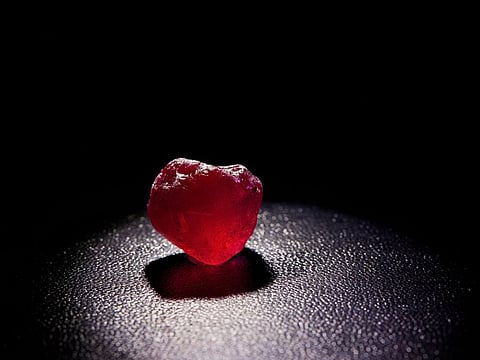Dubai firm Fura brings out 101-carat ruby, said to be world’s largest such ‘gem-quality’ stone mined
Fura’s Dev Shetty wants to bring back rubies and emeralds to equal footing with diamonds

Dubai: A Dubai company wants to upgrade rubies, emeralds and sapphires’ status to the same level as diamonds enjoy with jewellery shoppers. It will take some doing because coloured gemstones had lost out to diamonds in shopper preferences for decades now.
“That’s right, until the 1960s, the 70s, coloured gemstones were at par on a dollar-for-dollar basis,” said Dev Shetty, CEO of Fura Gems. “Then De Beers (the global diamond powerhouse) took the game away because they could put their considerable marketing prowess behind diamonds. They took over the mind of the global consumer.
“In comparison, rubies, emeralds and sapphires were mostly in the hands of small miners, and they never stood a chance against De Beers.”
Can this narrative be changed? Shetty hopes so, and he is showcasing a 101-carat ruby – the ‘Estrela De Fura – mined from the company’s own mine in Mozambique. It is said to be the world’s largest gem-quality ruby ever mined.
“Rubies are 20 times more rarer then diamond,” said Shetty. “Rubies over 20 carats or more are even rarer then pink diamonds. The ruby we are showcasing is over 100 carats and will be cut into a gem of over 50 carats.
“In 2015, a similar ruby was auctioned by Christie’s, called the ‘Sunrise Ruby’. It was a 25 carat polished ruby and sold for over $1.2 million a carat. The prices of rubies have since doubled - so one can guess what the price of a gem quality ruby over 50 carats would be.”
Diamond auctions have been fetching record prices at auctions, and recently, a pink diamond (another rarity) was showcased in Dubai ahead of its auction by Sotheby’s in Hong Kong next month.
De Beers’ handbook
Fura, headquartered at DMCC, launched in 2017, and the focus from the outset was on coloured gemstones exclusively. Diamonds never entered the frame at any point.
The company then bought outright ownership or majority stakes in mines in Colombia, Mozambique, Australia and Madagascar, and started trading in the rough stones mined from these via auctions. (There were also partnerships with other mine owners.)
It will not be easy to go head to head with diamonds all over again. “The rough diamonds trade is about $13 billion-$14 billion annually – compare that with the $2.5 billion for coloured gemstones,” said Shetty. “But there was a need to restart, and we are making progress. Our revenues are up 50-60 per cent, though from a low base.
“What worked for diamonds in creating an aura with consumers can be repeated with rubies and emeralds. Diamonds had a head start, but there will be a catch up.”
Those mines have years to go
Fura owns mines in Colombia (for rubies), Australia (sapphires), Mozambique (emeralds). The rough gemstones are then sold via auctions, which was taking place even during the Covid phase. But won’t ownership of mines be a significant add on, especially for a 5-year old entity like Fura? “These mines have longevity stretching from 25 years to 75 and even longer,” said Dev Shetty. We needed to control the entire process as much as we could. That meant ownerships or significant stakes in those mines where possible.”
On full display
The ‘Estrela de Fura’ ruby will be on display at the Diamond Exchange for a month. But viewings will be by appointment only. After the display run, it will go into a private auction next month. “The Estrela de FURA ruby is likely to yield an intense, saturated red colour once fully and properly faceted with adequate proportions,” said Dr. Daniel Nyfeler, Managing Director of Gübelin Gem Lab. “Compared to most rubies, including those from Burma, which tend to be fairly included when reaching sizes above 5 carats, this ruby is relatively free of eye-visible inclusions. Considering its very large size, the vivid red colour, and clarity characteristics of this ruby give it an extraordinary potential to become one of the largest high-quality faceted rubies ever seen.”
Sign up for the Daily Briefing
Get the latest news and updates straight to your inbox



